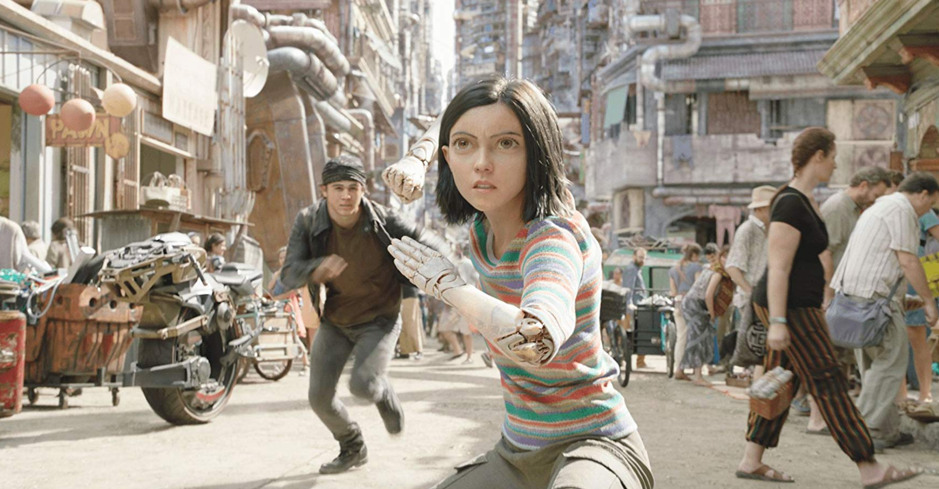Twenty years after James Cameron first became enamoured with the movie’s source material, a manga series created by Yukito Kishiro, Alita: Battle Angel is finally screening in cinemas. Having been preoccupied with other projects for years, Cameron recruited Robert Rodriguez as the director to help realise the cyberpunk vision for which he had an enduring passion. Together with co-producer Jon Landau, co-writer Laeta Kaligidis, and a cast of accomplished actors, they have created a movie that is visually stunning and enjoyable, but encumbered by a choppy plot.
Alita: Battle Angel is set in a dystopian future, after a great war has ravaged Earth, leaving only two cities. The privileged live in Zalem, a city in the sky, while workers and criminals live in the Iron City. The movie tells the story of a cyborg who is found in a scrapyard in the Iron City, and repaired by the compassionate Dr. Ido (Christoph Waltz), who names her Alita. When she regains consciousness, Alita (Rosa Salazar) realises that she cannot remember her past life. As she tries to rediscover her identity, Alita struggles against Dr. Ido’s overprotective tendencies and falls for a boy named Hugo (Keean Johnson), who introduces her to the violent sport of Motorball. Ultimately, Alita’s quest to find her destiny puts her on a collision course with Nova, a mysterious scientist in the sky city, and his numerous henchmen.
In an interview, Cameron said he had his daughter in mind when writing Alita, wanting to create an empowering female lead who could inspire young women. Rosa Salazar brings this vision to life with a strong motion-captured performance, creating a protagonist that is both fierce and relatable. Initially thinking that she is just an “insignificant girl,” Alita eventually finds out that she is a powerful fighter with the ability to change the world. Allegorically, the movie can be seen as her journey to find a place in society, while also dealing with themes of body alienation and acceptance. There are a plethora of other characters in the film, played by some notable names including Mahershala Ali, Jennifer Connelly and Ed Skrein, and many have skewed moral compasses that reflect their harsh surroundings. Several characters experience transformations that keep them engaging, with Alita acting as a catalyst for positive character change. Unfortunately, Alita’s love interest, Hugo, is one of the less interesting characters. His portrayal is bland and his lines are often unimaginative, making the film’s romance less convincing.
The visuals are probably the most impressive aspect of Alita: Battle Angel, and it should ideally be experienced in 3D. The movie feels grand and immersive, often reminiscent of Avatar. The action sequences initially feel riveting, enhanced by the well-timed use of slow motion to fully showcase Alita’s mesmerising fight moves. There is also a blistering Motorball scene and an entertaining bar fight, that prove Rodriguez’s ability to adapt his directing style to high-budget action. The setting of the eclectic Iron City also makes for some whimsical and dynamic visuals. Alita’s enlarged eyes are one of the more surprising stylistic choices in the film, and serve to make the character unique and expressive, although some viewers may find them unnatural.
Ultimately, it is the plot that hampers the movie the most. There’s a lot going on in Alita: Battle Angel, and it all feels somewhat rushed at times. Characters begin to appear in unexpected places with minimal explanation as the film tries to tie up several loose ends a little too quickly. The action sequences begin to drag towards the end, as does the over two hour running time, to the extent that some of the more subtle character arcs in the story sometimes feel lost amidst all the clamour. Despite its length, the movie declines to offer a conclusive ending, instead opting to set up a sequel. This lack of a resolution inevitably feels a little unsatisfying and will leave some moviegoers feeling frustrated.
Overall, Alita: Battle Angel is one of the better recent adaptations of non-US comics. The spectacular visuals and the engaging protagonist should make it enjoyable for many, although the untidy plot holds it back from achieving its full potential.
Words by Stefano Tudor

